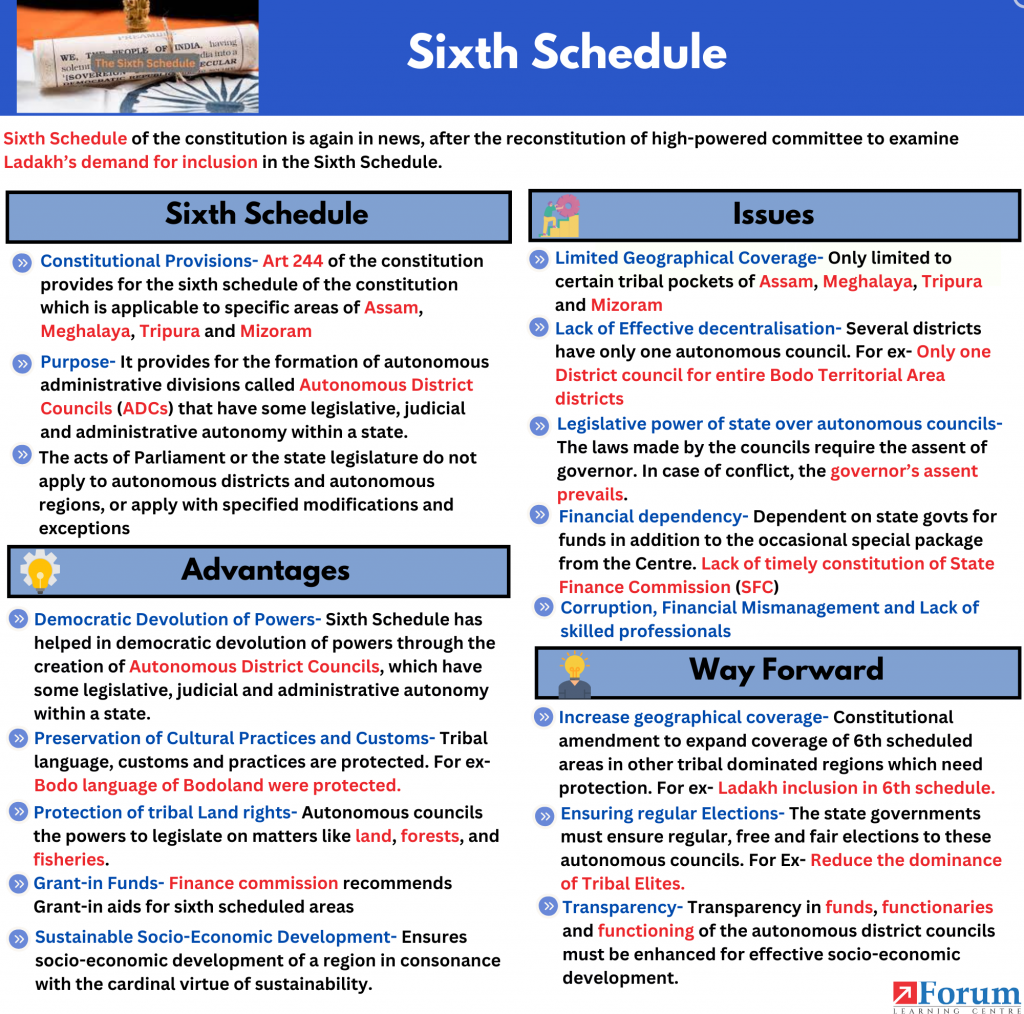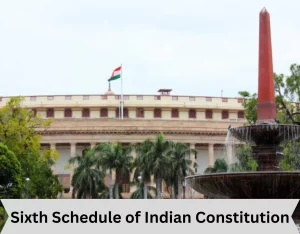ForumIAS announcing GS Foundation Program for UPSC CSE 2025-26 from 19 April. Click Here for more information.
Sixth Schedule of the constitution is again in news, after the reconstitution of high-powered committee to examine Ladakh’s demand for inclusion in the Sixth Schedule. Representatives of Ladakh like MP Jamyang Tsering Namgyal and eminent persons like Magsaysay Award Winner Sonam Wangchuk, have raised the demand repeatedly since the constitutional changes in the erstwhile state of Jammu and Kashmir in 2019.

What is the Sixth Schedule of Indian Constitution?
| Specifications | Details |
| Constitutional Provision | Art 244 of the constitution provides for the sixth schedule of the constitution. |
| Applies to | Assam, Meghalaya, Tripura and Mizoram |
| Purpose | It provides for the formation of autonomous administrative divisions called Autonomous District Councils (ADCs) that have some legislative, judicial and administrative autonomy within a state. |
| Composition of ADCs | 1) ADCs have up to 30 members with a term of five years. Of these, four are nominated by the governor and the remaining 26 are elected on the basis of adult franchise. 2) The Bodoland Territorial Council in Assam is an exception, with more than 40 members. 3) Each autonomous region also has a separate regional council. |
| Powers of ADCs | 1) Civil and judicial powers: They can constitute village courts within their jurisdiction to hear trials of cases involving the tribes. Governors specify the jurisdiction of high courts for each of these cases. 2) Legislative powers: The councils are empowered to make legislative laws on matters like land, forests, fisheries, social security, entertainment, public health, etc. with due approval from the governor. 3)The acts of Parliament or the state legislature do not apply to autonomous districts and autonomous regions, or apply with specified modifications and exceptions. |
Why is Ladakh Demanding Inclusion in The VI Schedule of The Constitution?
1. Political Representation and autonomy- The Jammu and Kashmir Reorganisation Act 2019, created two separate UTs of J&K (with legislature) and Ladakh (without legislature). While there had been four MLAs from the Ladakh region in the erstwhile J&K Assembly, now the administration of Ladakh is completely in the hands of bureaucrats. Thus, sixth schedule status is being demanded to ensure political representation and autonomy.
2. Lack of Local Employment opportunities- The administration of UT of Ladakh has failed to create local employment opportunities for youth of Ladakh. For Ex- Absence of a public service commission and lack of comprehensive job policy even after 4 years of creation of UT of Ladakh.
3. Preservation of Cultural Identity- Sixth schedule status is also being demanded to protect Ladakh’s unique cultural heritage and traditional customs. For ex- Tribals like Gujjars, Bakarwals, Bots, Changpas, Baltis and Purigpas have distinct cultures which can better be preserved under sixth schedule of the constitution.
4. Preservation of Ladakh’s Fragile ecosystem- Climate activists have raised flagged serious concerns regarding mining and industrialisation in the fragile glacial ecological system of Ladakh. Sixth schedule status is being demanded to protect the high-altitude deserts, glaciers and alpine meadows which are a crucial habitat for rare and endangered species.
5. Change in domicile policy of Jammu and Kashmir- The change of domicile policy in UT of J&K has amplified demands for sixth schedule for Ladakh to ensure domicile for Ladakh population.
6. Strengthening of democratic institutions- The establishment of autonomous councils under the Sixth Schedule would also strengthen democratic institutions at the grassroots level. For ex- More powers and autonomy to Ladakh Autonomous Hill Development Councils (LAHDC).
| Read More- What is the Sixth Schedule, and can Ladakh be included under it |
What are The Advantages of Being Included in The VI Schedule of The Constitution?
1. Democratic Devolution of Powers- Sixth Schedule has helped in democratic devolution of powers through the creation of Autonomous District Councils which have some legislative, judicial and administrative autonomy within a state.
2. Preservation of Cultural Practices and Customs- The inclusion of a region in the sixth schedule ensures protection of local language, cultural practices and customs. For ex- Bodo language of Bodoland were protected.
3. Protection of tribal Land rights- Sixth schedule has also helped in protection of agrarian and land rights by granting the autonomous councils the powers to legislate on matters like land, forests, and fisheries.
4. Grant-in Funds- Sixth schedule areas are provided with enhanced quantum of Grant-in Funds for rapid development and transformation. For ex- Finance commission recommendations for Grant-in aids for sixth scheduled areas
5. Sustainable Socio-Economic Development- The inclusion of a region in the sixth schedule ensures socio-economic development of a region in consonance with the cardinal virtue of sustainability.
What are The Issues with The VI Schedule of the Constitution?
1. Limited Geographical Coverage- The sixth schedule areas are limited in their geographical coverage and exclude numerous tribal communities, leading to unequal treatment and exclusion. For ex- Only limited to certain tribal pockets of Assam, Meghalaya, Tripura and Mizoram.
2. Lack of Effective decentralisation- The sixth schedule areas often lack effective and real decentralisation of powers and administration. For ex- Only one District council for entire Bodo Territorial Area districts.
3. Legislative power of state over autonomous councils- The laws made by the councils require the assent of governor. Also, in case of conflict of interest between the District Councils and the state legislature, the latter would prevail.
4. Financial dependency- Autonomous councils are dependent on their respective state governments for funds in addition to the occasional special package from the Centre. For ex- Lack of timely constitution of State Finance Commission for recommending devolution of funds to District Councils and Regional Councils.
5. Corruption and Financial Mismanagement- The functioning of different councils in the sixth schedule areas has been marred by corruption and financial mismanagement.
6. Lack of skilled professionals- The autonomous councils lack skilled planning professionals, which results in ill-conceived development projects without proper technical and financial consideration.
7. Lack of Codification of customary Laws- The councils have failed in codifying customary laws of the local tribal population.
Read More UPSC Topics-
What Should be The Way Forward?
1. Creation of elected Village Councils- Village councils must be created with their accountability to the local Gram Sabhas.
2. Ensuring regular Elections- The state governments must ensure regular, free and fair elections to these autonomous councils. For Ex- Reduce the dominance of Tribal Elites.
3. Representation of Women and other Ethnic Minorities- Women and other ethnic minorities must be provided adequate representation in these autonomous councils.
4. Increase geographical coverage- Constitutional amendment must be brought to expand coverage of 6th scheduled areas in other tribal dominated regions which need protection. For ex- Ladakh inclusion in 6th schedule.
5. Transparency- Transparency in funds, functionaries and functioning of the autonomous district councils must be enhanced for effective socio-economic development.
| Read More- The Indian Express UPSC Syllabus- GS-2 Issues related to Federal Structure |





